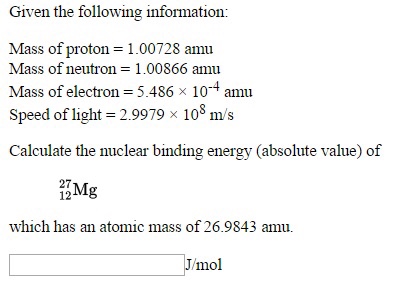- What Is Mass Of Electron In Amu
- Electron Rest Mass
- Mass Of A Proton Electron In Amu
- The Mass Of A Proton
In atomic mass units, what is the mass of an electron?
1 Answer
Therefor when we calculate amu the mass of electron is negated. Relative Mass of Proton Neutron and electron are In this relative mass calculation we have assume that a neutron has a mass of 1, then the relative masses of proton and electron are. Charge: Proton is a positively charged particle. Magnitude of charge: Charge of proton is 1.6022 x 10-19 coulomb. Mass of proton: Mass of proton is 1.0072766 a.m.u. Or 1.6726 x 10-27 kg. Comparative mass: Proton is 1837 times heavier than an electron. Position in atom: Protons are present in the nucleus of atom. For latest information, free computer courses and high impact notes visit: www.
Explanation:
The mass of an electron is listed as being equal to


What Is Mass Of Electron In Amu
The unified atomic mass unit, or
A carbon-12 atom has six protons and six neutrons in its nucleus and a molar mass of
Since you need
Therefore, you have
This means that the mass of an electron expressed in unified atomic mass units will be equal to


Related questions
(i) Proton is a positively charged particle having an absolute charge of + 1.6 x 10-19 coulombs. Since this is the smallest positive charge carried by a particle, so this is taken as the unit of positive charge and we say that the relative charge of a proton is + 1. The mass of a proton is about 1836 times that of an electron.
Image Source: profmattstrassler.files.wordpress.com/2011/07/myhydrogen.jpg
In other words, the mass of a proton is equal to the mass of 1836 electrons. The relative mass of a proton is 1 a.m.u. (1 atomic mass unit) which is the same as that of a hydrogen atom, the atom of lowest mass. The absolute mass of a proton is, however, 1.6 X 10-24 gram. Each element has a fixed number of protons in the nucleus of its atom, which is characteristic of that element. It is called atomic number of the element. No two elements can have the same number of protons in their atoms. It is due to the presence of protons that nucleus of an atom is positively charged.
Electron Rest Mass
(ii) Electron is a negatively charged particle having an absolute charge of, – 1.6 x 10-19 coulombs. Since this is the smallest negative charge carried by a particle, so this is taken as the unit of negative charge, and we say that the relative charge of an electron is, – 1. The charge of an electron is equal in magnitude but opposite in sign to the charge of a proton. A normal atom has an equal number of protons and electrons and since a proton and an electron have equal and opposite charge, an atom on the whole is electrically neutral. Electron is the lightest of the three atomic particles.
The mass of an electron is about 1/1836 of the mass of a hydrogen atom (which is the atom 1836 of lowest mass). Since the mass of a hydrogen atom is 1 amu (1 atomic mass unit), we can say that the relative mass of an electron is 1/1836 amu. The absolute mass of an electron is, however, 9 x 10-28 gram. The electron in an atom possesses a certain amount of energy to maintain its distance from the oppositely charged nucleus. Without this energy, the electron would collapse into the nucleus.
Mass Of A Proton Electron In Amu
(iii) Neutron Is an uncharged particle or neutral particle which is present in the nucleus of an atom. Only one element, ordinary hydrogen, does not contain neutron in the nucleus of its atoms, the nuclei of all other elements contain neutrons. The mass of a neutron is the same as that of a proton. Thus, the relative mass of a neutron is 1 amu. The relative charge of a neutron is, however, zero (0). Since both the heavier particles, protons and neutrons, are present in the nucleus, so practically the whole mass of an atom is concentrated at its nucleus, the mass of electrons being negligible.
The Mass Of A Proton
Related Articles:
